Guzmania is an evergreen tropical representative of epiphytic plants, who came to Europe from the forests of America. The decorative appearance of bracts in the form of cones, which for a long period of time retain their beauty, has become the reason for the wide popularity of the plant among flower growers. However, caring for guzmania at home requires certain knowledge that should be gathered before the appearance of tropical culture in the home.
Material Content:
Guzmania: important growing requirements
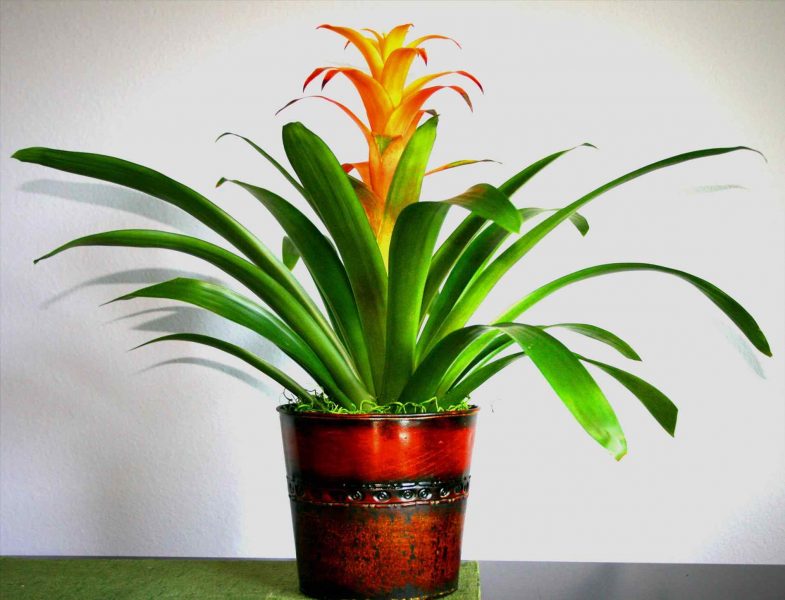
A plant belonging to the bromeliad family, being a representative of the tropical flora, has its own requirements that must be considered when growing at home:
- a large amount of stray light;
- regular watering and high humidity;
- moderation of temperature;
- seating of children after the death of the maternal outlet.
Types and varieties of flower
In the natural environment, the genus has more than 30 species, some of which are cultivated as potted crops.

Among the most popular are:
- Guzmania reed is the most common species in indoor floriculture that can grow on rocky ground and is represented by rosette plants. A corolla is formed in the center of the leaf rosette, consisting of bright bracts that frame a spike-like, inconspicuous inflorescence.Popular varieties: guzmania Minor Rondo with lemon and red bracts, modest guzmania with light orange bracts with bright tips.
- Guzmania blood red - plants with rosettes in the form of a glass, consisting of wide leaves, and bright red bracts formed around corymbose inflorescences. A common form is short-legged guzmania with pointed bracts in the form of a helmet and bloody guzmania.
- Guzmania Donnela Smith - a view with a loose rosette, which is formed by green leafy plates covered with scales of light colors. The pyramidal inflorescence is slightly covered by intense red bracts.
- Guzmania Tempo is a species that stands out with a golden-green color of leaf plates forming a sprawling rosette. Bracts are typical red.
- Guzmania is mosaic - long leaves of this species are collected in a rosette, from the center of which a low peduncle develops, crowned with a simple capitate inflorescence with pointed pink elliptical bracts.
Home Care
For successful cultivation of guzmania in an apartment environment, it is necessary to provide the plant with conditions close to natural.
Lighting and location

Since the natural habitat of the plant is tropical forests, the flower needs abundant, but diffuse lighting. The best solution for placing the flower will be to install it on the windowsill of eastern or western windows with protection from direct sunlight.
Temperature
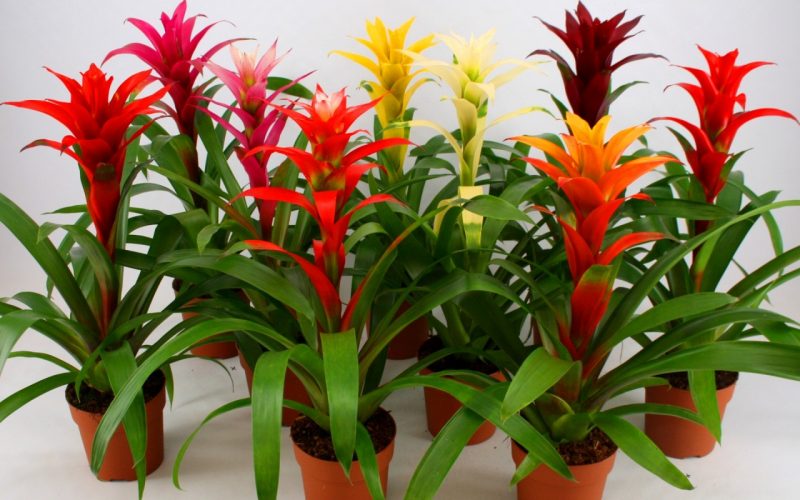
In the flowering phase, guzmania needs to maintain a temperature of 25 ° C. However, after its completion, the plant feels comfortable at 20-22 ° C. The maximum permissible temperatures are 27 ° C and 13 ° C, the establishment of a temperature regime above and below which, respectively, can cause the death of the flower.
Watering
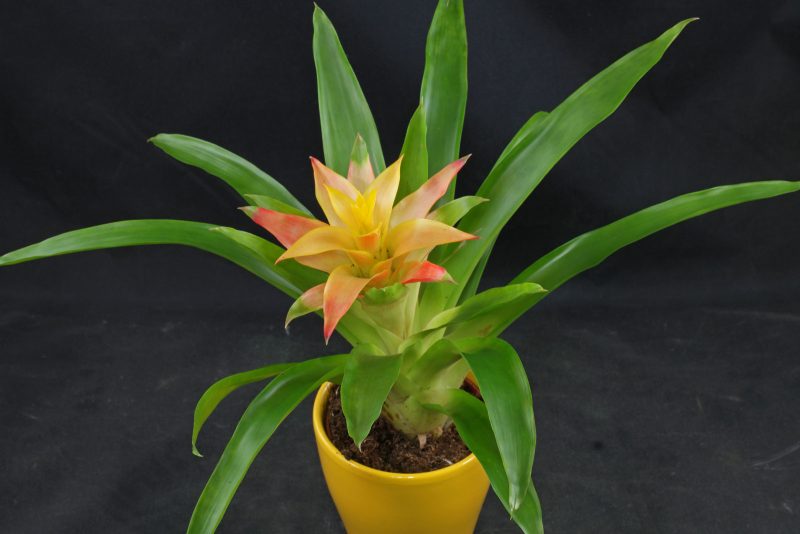
Guzmania should be watered with warm, filtered water that does not contain chlorine directly into a leaf outlet. When establishing an irrigation system, you need to know that the earthen lump should not dry out, constantly remaining slightly moist.
Air humidity
A representative of the bromeliads needs daily spraying, which should also be carried out with warm, purified water. In the autumn-winter period, spraying the culture is necessary exclusively in the morning.
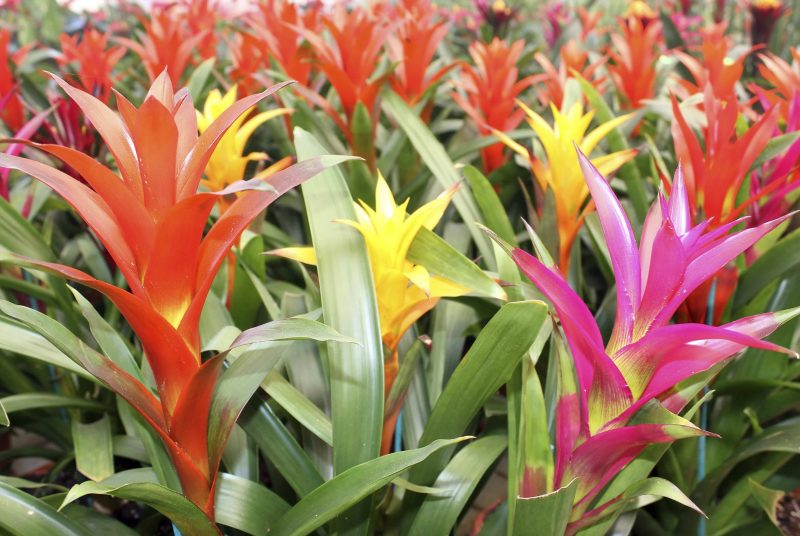
Caution! Spraying water on bracts can significantly reduce flowering time.
Top dressing
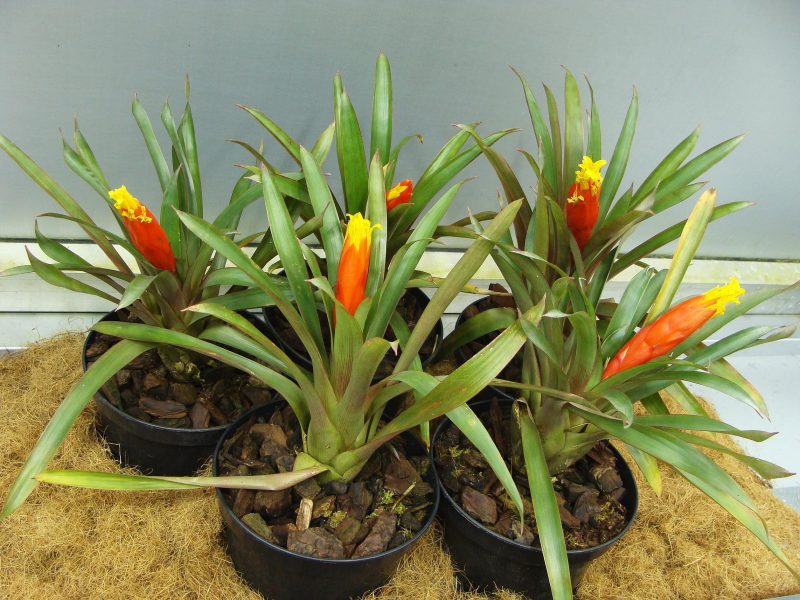
Guzmania during the active growing season is fed with the foliar method every month. As fertilizers, special complexes are used for bromeliads, from which boron and copper should be excluded.
Guzmania transplant - how to?
Only once during the entire life cycle of a plant may a transplant be necessary - after purchase from a shipping container to a permanent pot.
When transplanting:
- Due to the small root system of the plant, a weighted pot of small diameter (10-12 cm) is selected.
- A drainage layer is placed at the bottom.
- Guzmania is transferred from the old tank together with the old substrate into a permanent pot.
- The free space is covered with a light soil mixture of sand, humus, sod land and peat in a ratio of 1: 2: 2: 4.
Advice! If there is no possibility or desire to independently prepare the soil mixture with the necessary parameters, then you can purchase a ready-made substrate for orchids or ferns in a flower shop.
Guzmania after flowering - the nuances of care
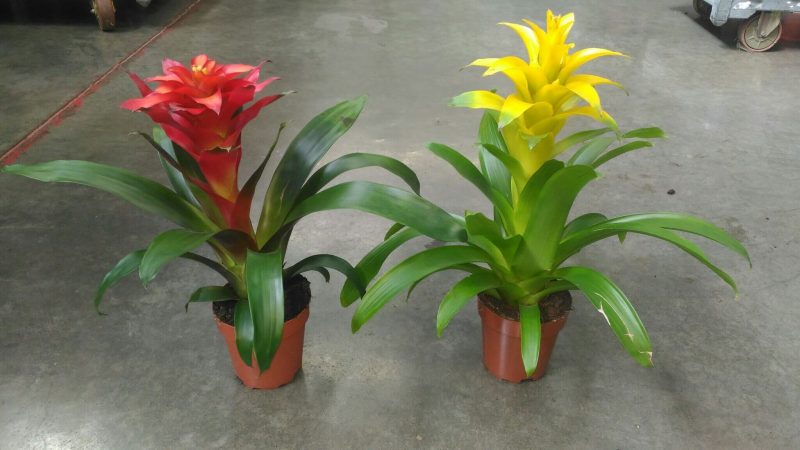
Annual guzmania is conventionally considered a perennial plant, since it usually takes three years to bloom. But after flowering, which lasts several months, the culture dies.The only thing that can be done is to obtain new specimens using the lateral processes that will form after the death of the mother outlet.
Protection against diseases and pests
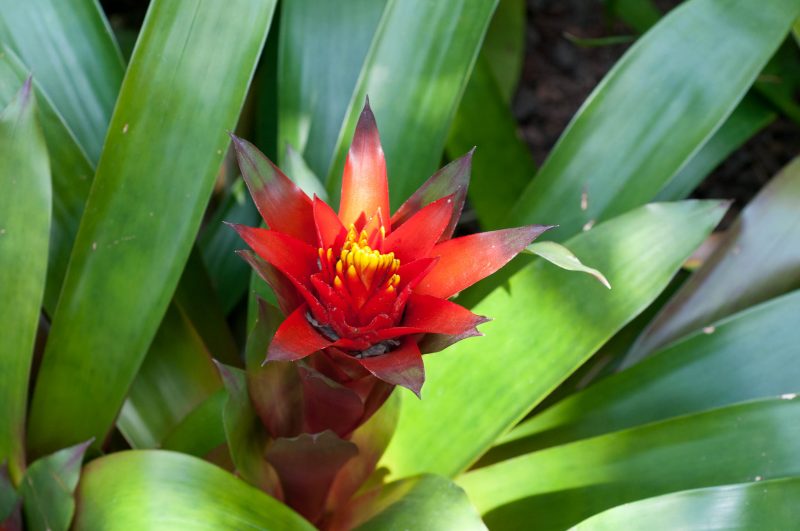
In case of violation of the regulations for the maintenance of a tropical representative, guzmania can be affected by a number of harmful organisms:
- Among the pests with a low level of moisture on the culture, a spider mite, a mealybug and a scabbard are noted, upon detection of which the plant should be sprayed with a working solution of an insecticidal preparation according to the instructions indicated on the package.
- In the case of excess moisture in the soil and in the air on guzmania, powdery mildew and gray rot develop, which should be treated immediately after the first signs are detected. Being late with timely treatment may threaten the death of the flower.
Reproduction of indoor flower
Guzmania multiplies by lateral processes (children) and seeds.
Kids
At the end of the flowering phase, which is observed in the spring-summer period, the maternal specimen dies. Around lateral processes are formed, in which their own roots gradually develop.
When the root system of the lateral processes reaches a length of 1.5 cm, the following steps are taken:
- The process is separated by a sharp, disinfected knife.
- Places of cuts are processed by crushed coal (wood or activated).
- The child sits in a pot with an air- and water-permeable substrate for orchids.
- The container is covered with a plastic bag to create greenhouse conditions and moves to a warm, bright place.
- After the new instance has gained strength, the guzmania flower is transplanted into a permanent pot by transplantation.
Attention! The root system of each process is formed at a different speed, so the seating process can take quite a long time.
Seeds
To breed guzmania, you can resort to the seed method, which is more time-consuming and does not always end in success.

With generative reception:
- In the flower shop purchased seed of the desired type and variety.
- The shift is immersed in a prepared solution of potassium permanganate, where they are kept for about 20 minutes to destroy pathogens and other harmful microorganisms.
- At this time, a loose and light substrate is prepared from peat and sand in equal proportions, which is calcined in the oven and placed in a seedling box.
- Disinfected seeds are distributed on the surface of the moistened substrate.
- The box is covered with glass and moved to a bright place where the temperature is held at 25 ° C.
- After 20 days, the first sprouts appear, which dive after the formation of two pairs of true leaves.
- In a permanent pot, the plant is transplanted after it is well strengthened.
What problems can flower growers face?
If a florist learns the basic rules for caring for guzmania before acquiring a flower, he will be able to avoid most problems. However, due to the tropical nature of the plant, the likelihood that difficulties can nevertheless arise is quite high.

Among the main problem situations stand out:
- Lack of flowers - the problem is often associated with a violation of the general rules for the maintenance of the plant, including lack of lighting, poor soil, insufficient humidity. To correct the situation, it is necessary to review the care and identify non-compliance, as well as stimulate the flower by placing an apple and a banana next to the pot. To ensure that ethylene gas does not escape, it is recommended to place the pot with fruits under a plastic bag.
- Leaf wilting - the situation is observed when water enters the outlet, the development of rot, or in the case of the colonization of a flower by pests. Normalization of the irrigation system and chemical treatment of the plant will easily cope with this difficulty.
- Slowed growth - poor soil composition and lack of coverage are the main inhibiting factors affecting the development of guzmania.
Thus, if you correctly approach the process of growing guzmania and initially study all the features and nuances of care, a rosette flower will become an exquisite decoration of any interior with minimal expenses for the florist’s free time.












